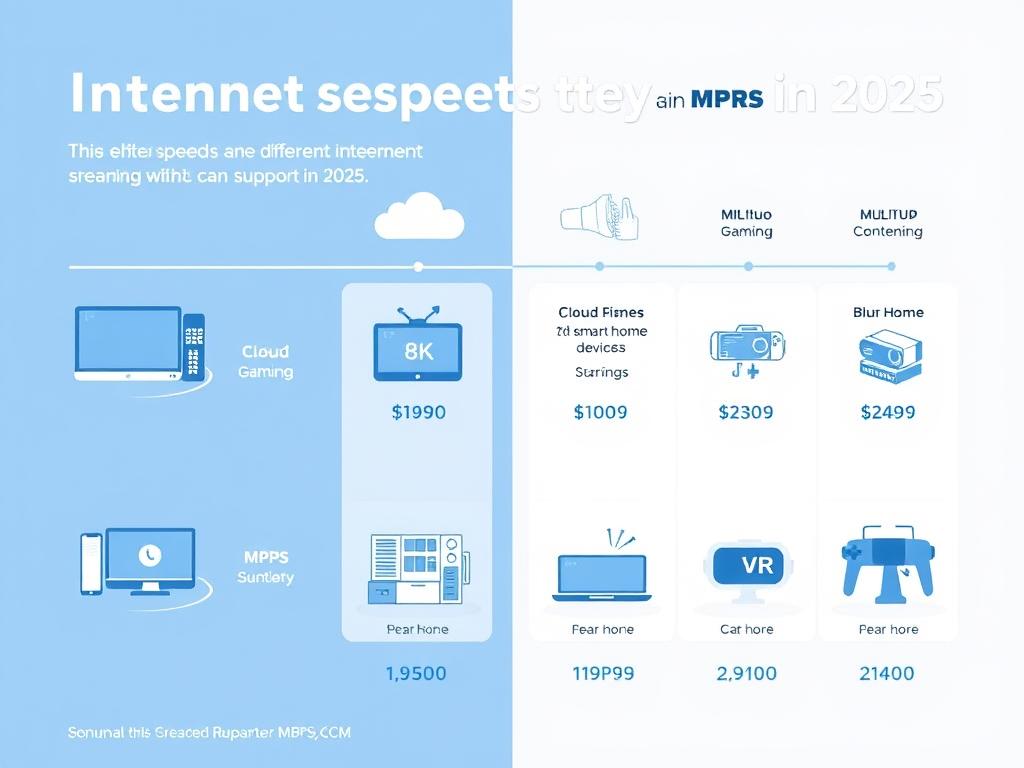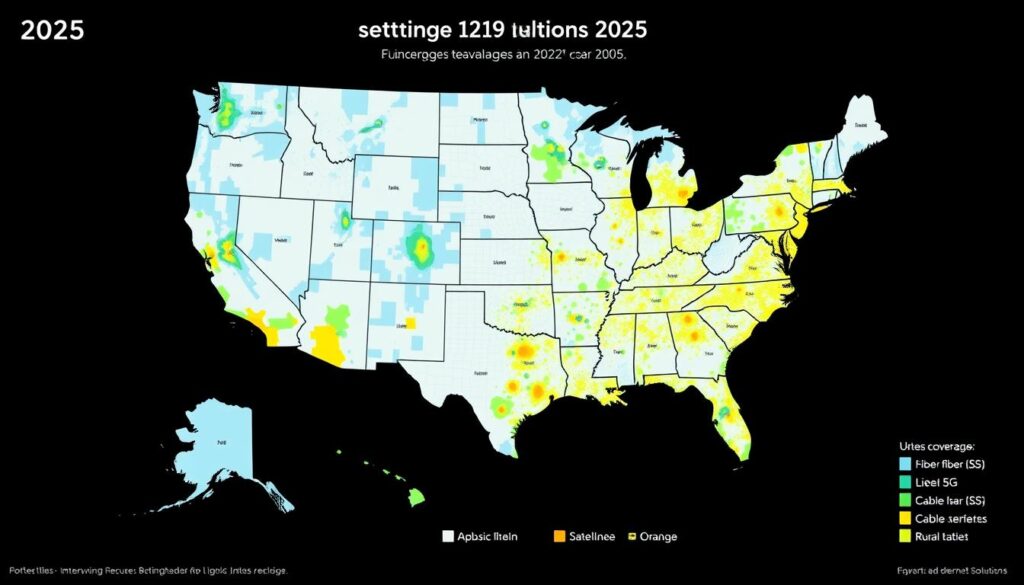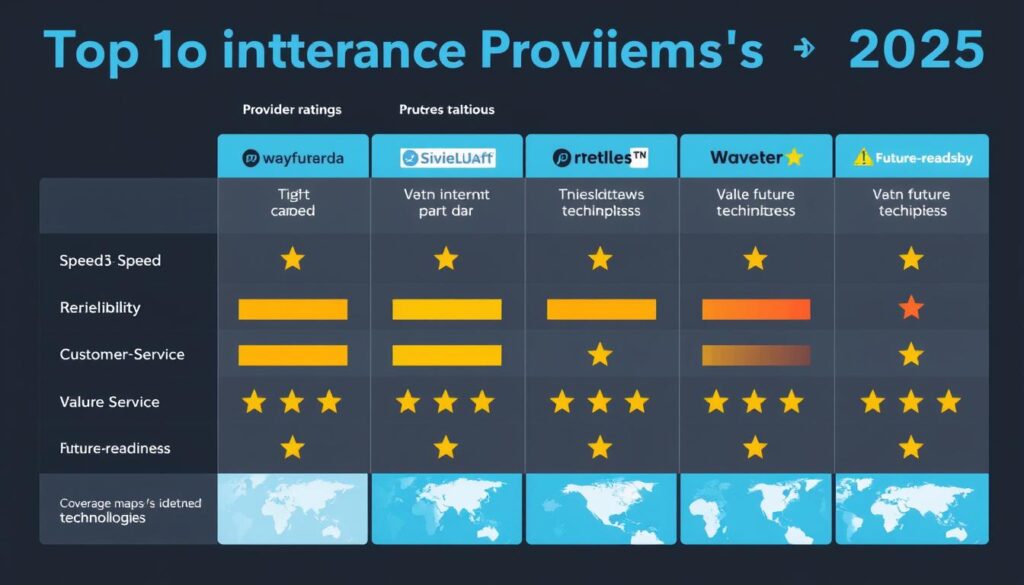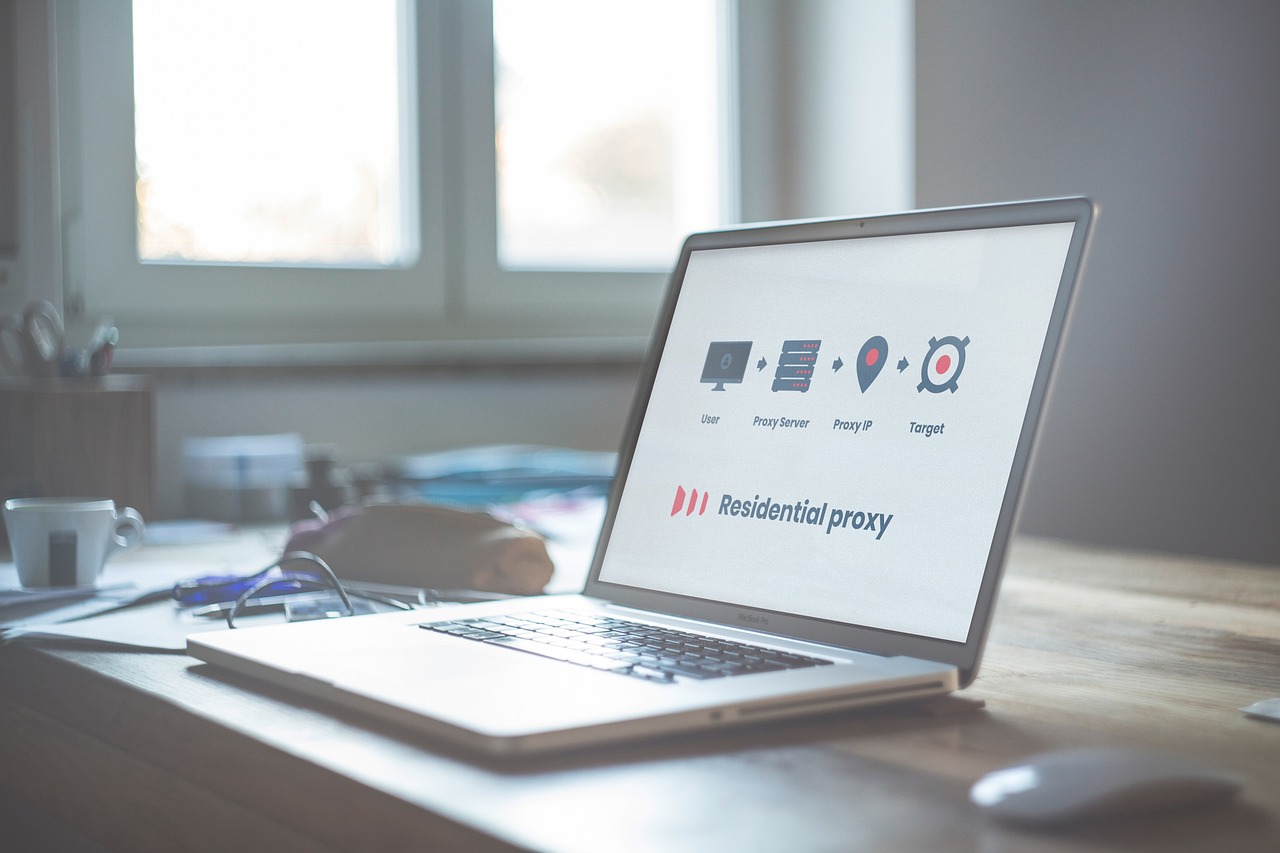Why Your Choice of Home Internet Provider Matters in 2025
The average American household now has over 25 connected devices, from laptops and smartphones to smart appliances and security systems. This interconnected ecosystem demands more from your home internet than ever before. A reliable, high-speed connection isn’t just a convenience—it’s essential infrastructure.
Remote Work Revolution
With 65% of professional jobs now offering remote or hybrid options, your home internet needs to support video conferencing, cloud computing, and secure file transfers without interruption.
Smart Home Integration
The average home in 2025 contains 12+ smart devices that require constant connectivity. Your internet provider needs to handle this ecosystem reliably.
Entertainment Evolution
8K streaming, cloud gaming, and virtual reality experiences demand unprecedented bandwidth and low latency that only certain providers can deliver consistently.
Selecting the right home internet provider isn’t just about finding the lowest price—it’s about ensuring your digital life runs smoothly today and adapting to tomorrow’s innovations. Let’s explore the key factors to consider when making this important decision.
Understanding Speed Requirements for 2025
Internet speed requirements have evolved significantly as technology advances. What was considered “fast” just a few years ago may now be inadequate for many households. Understanding your specific needs is the first step in choosing the right home internet provider.

Speed Requirements by Household Type
| Household Type | Recommended Download Speed | Recommended Upload Speed | Best Technology |
| Single user, basic browsing | 100-200 Mbps | 10-20 Mbps | Cable, 5G, Fiber |
| Small family, moderate streaming | 300-500 Mbps | 20-50 Mbps | Cable, Fiber |
| Remote workers, video conferencing | 500-1000 Mbps | 100+ Mbps | Fiber, Advanced 5G |
| Power users, 8K streaming, gaming | 1-2 Gbps | 300+ Mbps | Fiber, Next-gen Cable |
| Smart home enthusiasts (10+ devices) | 500+ Mbps | 50+ Mbps | Fiber, Advanced 5G |
2025’s Internet Technology Landscape
Fiber Internet
Fiber internet remains the gold standard in 2025, offering symmetrical speeds up to 10 Gbps in some areas. Fiber plans typically start around $50/month for 500 Mbps and range up to $150/month for multi-gigabit connections. The technology provides the most reliable and future-proof connection available.
5G Home Internet
5G home internet has matured significantly, now offering speeds comparable to cable (300-900 Mbps) with improved reliability. Coverage has expanded to over 85% of urban and suburban areas, with prices typically ranging from $50-80/month, often with discounts when bundled with mobile plans.
Next-Gen Satellite
Low-earth orbit satellite networks have revolutionized rural internet access, offering speeds of 100-500 Mbps with dramatically reduced latency (20-40ms) compared to traditional satellite. Monthly costs range from $80-120, making it viable for remote locations where fiber isn’t available.
Not Sure What Speed You Need?
Use our speed calculator to determine the optimal internet speed based on your household size, connected devices, and online activities.
Coverage and Reliability in 2025
Even the fastest internet plan is worthless if the service is unreliable or unavailable in your area. In 2025, coverage has expanded significantly, but important differences remain between providers and technologies.

Infrastructure Developments
The Infrastructure Investment and Jobs Act of 2021 has significantly expanded internet access by 2025. Over $65 billion in funding has helped extend fiber networks to previously underserved areas and upgrade existing infrastructure. This expansion means more competition in many markets, giving consumers more options than ever before.
Urban vs. Rural Availability
Urban areas now enjoy near-universal access to fiber or high-speed cable options, with multiple providers competing in most markets. Rural coverage has improved dramatically, with 5G fixed wireless and next-generation satellite providing viable alternatives where fiber deployment remains economically challenging.
Before committing to any provider, verify actual availability at your specific address. Coverage maps can be misleading, and service quality can vary even within neighborhoods.
Reliability Metrics to Consider
- Uptime percentage (look for 99.9% or higher)
- Average outage frequency and duration
- Peak-hour performance degradation
- Weather resistance (especially important for wireless and satellite)
- Customer satisfaction scores for reliability
- Service level agreements (SLAs) for business-class services
Pro Tip: Ask potential providers for their average uptime statistics in your specific neighborhood, not just their overall network claims. Some providers now offer reliability guarantees with service credits for extended outages.
Check Provider Availability in Your Area
Enter your address to see which home internet providers offer service at your location, along with reliability ratings from current customers.
Understanding Pricing Models and Hidden Fees
Internet pricing has evolved significantly by 2025, with new subscription models and greater transparency in some areas, but also new potential costs to watch for. Understanding the full cost picture is essential to finding the best value.

Common Pricing Structures in 2025
Traditional Tiered Pricing
Most providers still offer speed-based tiers, but the entry-level speeds have increased significantly. Base plans now typically start at 300 Mbps, with premium tiers offering 2-10 Gbps. Monthly costs range from $40-150 depending on speed and provider.
Usage-Based Models
Some providers have introduced more sophisticated usage-based pricing, with base rates for standard usage and dynamic pricing during peak hours or for premium applications like cloud gaming and VR streaming. These plans can save money for light users but may cost more for heavy users.
Subscription Bundles
Comprehensive digital lifestyle bundles have become common, combining home internet with mobile service, streaming platforms, cloud storage, and even smart home security monitoring. These bundles often provide significant savings compared to purchasing services separately.
Identifying and Avoiding Hidden Fees
| Fee Type | What to Watch For | How to Avoid It |
| Equipment Rental | Monthly charges of $10-25 for modems and routers | Purchase compatible equipment outright or choose providers offering included equipment |
| Installation & Activation | One-time fees ranging from $50-200 | Look for promotional waivers or self-installation options |
| Data Overage Charges | Extra costs when exceeding data caps (typically $10-15 per 50GB) | Choose plans with unlimited data or monitor usage carefully |
| Price Increases After Promotional Period | Introductory rates that increase by 25-50% after 12-24 months | Look for price-lock guarantees or renegotiate before promotions expire |
| Early Termination Fees | Penalties for canceling before contract ends ($10-20 per remaining month) | Choose no-contract options or providers that will buy out existing contracts |
| Network Access Fees | Ambiguous monthly charges of $5-10 for “network maintenance” | Compare advertised price with final monthly bill before committing |
“The best value isn’t always the lowest advertised price. Calculate the total cost of ownership over 24 months, including all fees and equipment costs, to make a fair comparison between providers.”
Compare Total Cost of Ownership
Use our comparison tool to see the true cost of different internet plans in your area, including all fees and equipment costs over a 24-month period.
Evaluating Customer Service Quality
Customer service remains a critical differentiator among home internet providers in 2025. While technology has improved self-service options, the quality of support when problems arise can make or break your experience with a provider.

The Evolution of Internet Provider Support
AI-Powered Support
By 2025, most providers have implemented sophisticated AI systems that can diagnose and resolve common issues without human intervention. These systems can monitor your connection in real-time, proactively identify potential problems, and even schedule technician visits when necessary.
The best providers now offer augmented reality troubleshooting, where AI guides you through fixing issues using your smartphone camera to visualize your equipment setup.
Human Support Access
Despite advances in automation, access to knowledgeable human support remains crucial for complex issues. Leading providers now offer dedicated support teams for different types of services (gaming, smart home, business applications) rather than general technicians.
Look for providers offering 24/7 support through multiple channels (phone, chat, video) and check average wait times in customer reviews.
Customer Service Metrics to Consider
Research Tip: Check independent review sites and social media for recent customer experiences with your potential providers. Pay special attention to how companies handle outages and service disruptions, as these situations reveal their true customer service quality.
Read Verified Customer Reviews
See what real customers are saying about their experiences with internet providers in your area.
Future-Proofing Your Home Internet
Technology evolves rapidly, and what seems cutting-edge today may be obsolete tomorrow. When selecting a home internet provider in 2025, consider how well they’re positioned to support emerging technologies and increasing bandwidth demands.

Emerging Technologies Driving Bandwidth Needs
Immersive Reality
VR and AR applications have matured significantly by 2025, with mainstream adoption driving bandwidth requirements. High-fidelity VR experiences now require 50-100 Mbps per user with ultra-low latency, while AR applications integrated into daily life need consistent connectivity for real-time data overlays.
8K Streaming & Beyond
8K streaming has become standard for premium content, requiring 80-100 Mbps per stream for optimal quality. Next-generation volumetric video and holographic content is emerging, with bandwidth needs exceeding 200 Mbps per stream. Multiple viewers in one household can quickly saturate connections below 1 Gbps.
Advanced IoT Ecosystem
Smart homes in 2025 feature dozens of connected devices, from security systems and appliances to environmental controls and health monitors. While individual devices use modest bandwidth, their aggregate demand—especially for real-time video processing and AI functions—requires robust, reliable connectivity.
Provider Future-Readiness Assessment
| Future-Proofing Factor | What to Look For | Why It Matters |
| Network Architecture | Fiber-to-the-home or next-gen infrastructure with clear upgrade paths | Determines maximum potential speeds and how easily the network can be upgraded |
| Symmetrical Speeds | Equal or near-equal upload and download capabilities | Essential for cloud services, content creation, and two-way applications like VR |
| Infrastructure Investment | Ongoing network upgrades and expansion plans | Indicates provider’s commitment to keeping pace with technology |
| Technology Partnerships | Collaborations with content platforms, device manufacturers, and tech innovators | Suggests forward-thinking approach to emerging applications |
| IPv6 Implementation | Full support for the latest internet protocol | Necessary for expanding IoT ecosystems and network security |
Warning: Providers still relying primarily on legacy DSL or coaxial infrastructure without clear fiber upgrade paths will likely struggle to meet bandwidth demands beyond 2027. Consider their upgrade timeline before committing to long-term contracts.
Find Future-Ready Internet Providers
Compare providers based on their technology roadmaps and ability to support emerging applications.
Sustainability Initiatives in Home Internet
Environmental considerations have become increasingly important in the telecommunications industry. By 2025, many consumers are factoring sustainability into their provider selection process, and companies have responded with meaningful initiatives.

Green Initiatives in the Internet Industry
Renewable Energy Adoption
Leading providers have made significant progress in powering their networks with renewable energy. Data centers and network infrastructure now commonly utilize solar, wind, and other sustainable power sources. Some providers offer “green internet” plans that guarantee 100% renewable energy usage for your service.
When evaluating providers, look for published sustainability reports with specific metrics and targets rather than vague “eco-friendly” claims.
Equipment and E-Waste Programs
The environmental impact of networking equipment has been addressed through energy-efficient designs, longer device lifecycles, and comprehensive recycling programs. Leading providers now offer biodegradable packaging, energy-efficient modems and routers, and take-back programs for obsolete equipment.
Some providers have introduced refurbished equipment options that reduce environmental impact while lowering costs for consumers.
Comparing Provider Sustainability Efforts
Industry Leaders
- 100% carbon-neutral operations
- Renewable energy for all data centers
- Comprehensive equipment recycling programs
- Energy-efficient networking hardware
- Transparent sustainability reporting
- Community environmental initiatives
Lagging Providers
- Limited or no carbon reduction goals
- Minimal renewable energy investment
- No formal equipment recycling program
- Energy-inefficient legacy infrastructure
- Lack of sustainability transparency
- No clear environmental roadmap
“By 2025, the telecommunications industry has made significant strides in sustainability, with the most progressive providers achieving carbon neutrality and implementing circular economy principles throughout their operations.”
Find Eco-Friendly Internet Providers
Compare the sustainability initiatives of internet providers in your area and choose one that aligns with your environmental values.
Comparison of Top Home Internet Providers in 2025
The competitive landscape for home internet providers has evolved significantly by 2025. Here’s how the leading providers compare across key factors to help you make an informed decision.

| Provider | Technology | Speed Range | Starting Price | Standout Features | Best For |
| Quantum Fiber | Fiber Optic | 500 Mbps – 8 Gbps | $65/month | Symmetrical speeds, no data caps, 5-year price lock | Remote workers, content creators, multi-user households |
| Spectrum Ultra | Hybrid Fiber-Coax | 300 Mbps – 2 Gbps | $49.99/month | Wide availability, no contracts, bundling options | Families, streaming enthusiasts, value seekers |
| Verizon NextGen | Fiber + 5G Integration | 300 Mbps – 5 Gbps | $59.99/month | Mobile integration, advanced security, premium content bundles | Tech enthusiasts, smart home users, mobile-first households |
| Starlink Premium | Low-Earth Orbit Satellite | 150 Mbps – 500 Mbps | $110/month | Global coverage, low latency, portable options | Rural users, travelers, backup connectivity |
| T-Mobile Home+ | 5G Fixed Wireless | 100 Mbps – 1 Gbps | $50/month | Simple pricing, no equipment fees, mobile bundling | Apartment dwellers, budget-conscious users, mobile customers |
Detailed Provider Profiles
Quantum Fiber
Coverage: Available in 65% of urban and suburban areas across 42 states
Technology: Pure fiber-optic network with next-generation XGS-PON architecture
Unique Selling Point: Industry-leading symmetrical speeds with guaranteed performance SLAs even for residential customers
Sustainability: 100% carbon-neutral operations with comprehensive equipment recycling program
Spectrum Ultra
Coverage: Extensive presence in 41 states with both urban and suburban coverage
Technology: Hybrid network with expanding fiber backbone and DOCSIS 4.0 last-mile
Unique Selling Point: Flexible no-contract options with comprehensive entertainment bundles
Sustainability: 75% renewable energy with commitment to reach 100% by 2027
Verizon NextGen
Coverage: Strong presence in Northeast and expanding in other regions
Technology: Integrated fiber and millimeter wave 5G network
Unique Selling Point: Seamless integration between home and mobile connectivity with unified billing and management
Sustainability: 90% carbon-neutral with industry-leading green infrastructure initiatives
Compare Providers in Your Area
Enter your address to see detailed comparisons of internet providers available at your location, including speeds, pricing, and special offers.
Negotiating the Best Deal and Understanding SLAs
Getting the best value from your home internet provider often requires more than simply accepting the advertised offer. With the right approach to negotiation and a clear understanding of service guarantees, you can secure better terms and protect your interests.

Effective Negotiation Strategies
Research Before Contact
- Document competitive offers in your area
- Understand the provider’s regular vs. promotional pricing
- Check if you qualify for any special programs (low-income, student, senior)
- Review your usage patterns to know exactly what you need
- Check online forums for recent successful negotiation reports
Negotiation Tactics That Work
- Speak with the retention department directly
- Be polite but firm about your budget constraints
- Ask specifically about unadvertised promotions
- Request waived equipment fees or installation costs
- Negotiate for longer promotional pricing periods
- Consider annual pre-payment for additional discounts
Understanding Service Level Agreements (SLAs)
By 2025, many residential internet plans now include formal SLAs that were previously only available to business customers. These agreements define the provider’s commitments regarding service quality and reliability.
| SLA Component | What to Look For | What to Negotiate |
| Uptime Guarantee | Commitment to 99.9% or higher availability | Automatic credits for outages exceeding 1 hour |
| Speed Performance | Guaranteed minimum speeds (not just “up to” claims) | Right to downgrade or cancel if consistently below 80% of advertised speeds |
| Latency Commitments | Maximum latency thresholds for gaming and video conferencing | Performance testing procedures and remediation steps |
| Installation & Service Windows | Specific time windows rather than all-day appointments | Credits for missed appointments or late arrivals |
| Technical Support Response | Maximum wait times and issue resolution timeframes | Escalation paths for persistent issues |
“The difference between a good internet deal and a great one often comes down to what you negotiate beyond the advertised price. Equipment fees, installation costs, and contract terms are all negotiable with most providers.”
Pro Tip: Keep records of all service disruptions, speed tests, and support interactions. This documentation strengthens your position when negotiating credits or improved terms with your provider.
Get Personalized Negotiation Tips
Answer a few questions about your internet needs and location to receive customized negotiation strategies for getting the best possible deal.
Emerging Technologies Shaping Home Internet in 2025
The internet landscape continues to evolve rapidly, with several emerging technologies poised to transform home connectivity in the coming years. Understanding these developments can help you choose a provider positioned to leverage these innovations.

6G Development
While 5G deployment is still expanding, early 6G trials have begun in research environments. Expected to reach speeds of 1 Tbps with sub-millisecond latency, 6G will enable entirely new applications beyond current imagination. Leading providers are already investing in 6G research to position themselves for the next generation of connectivity.
Quantum Networking
Quantum communication technologies are moving from theoretical to practical applications, with initial deployments focused on ultra-secure communications. Providers with quantum-secured backbones will offer unprecedented security guarantees, particularly valuable for sensitive applications like financial transactions and healthcare data.
Advanced Mesh Systems
Next-generation mesh networking has evolved beyond simple Wi-Fi extension to create intelligent, self-optimizing home networks. These systems dynamically allocate bandwidth based on application needs, automatically troubleshoot connectivity issues, and provide granular control over device prioritization and security policies.
Regulatory Changes Affecting Home Internet
Net Neutrality Evolution
After years of policy shifts, a comprehensive federal framework for internet regulation has emerged. The Internet Fairness Act of 2024 established clear rules preventing throttling and paid prioritization while allowing reasonable network management practices. When evaluating providers, consider their track record on treating all internet traffic equally.
Broadband as Essential Infrastructure
Federal policy now classifies broadband as essential infrastructure, similar to electricity and water. This designation has expanded funding for universal access initiatives and created minimum service standards that all providers must meet. Some states have implemented additional consumer protections, including price transparency requirements and service quality benchmarks.
Looking Ahead: When selecting a home internet provider in 2025, consider not just their current offerings but their investment in emerging technologies. Providers actively participating in 6G research, quantum networking, and advanced security will be better positioned to deliver cutting-edge services in the future.
Stay Informed About Internet Innovation
Subscribe to our newsletter for updates on emerging internet technologies and how they’ll affect your home connectivity options.
Frequently Asked Questions About Home Internet in 2025
Is fiber still the best option in 2025?
For most urban and suburban locations, fiber remains the gold standard for home internet in 2025. It offers the best combination of speed, reliability, and future-proofing. However, advanced 5G fixed wireless has closed the gap significantly, offering comparable performance in many scenarios with easier installation. For rural areas, next-generation satellite services now provide viable alternatives with dramatically improved speeds and latency compared to previous satellite options.
How much speed do I really need in 2025?
By 2025, the baseline recommendation for a connected household is 300 Mbps download and 100 Mbps upload. This accommodates standard usage patterns including 4K streaming, video conferencing, and multiple connected devices. Households with heavy usage (multiple 8K streams, cloud gaming, VR applications) or more than 15 connected devices should consider plans offering 500-1000 Mbps. Remote workers who regularly transfer large files or participate in multiple video conferences should prioritize plans with symmetrical speeds.
Are data caps still common in 2025?
Data caps have become less common by 2025, with most major providers offering unlimited data on their standard plans. Where caps do exist, they’ve typically increased to 5TB or more per month, sufficient for all but the heaviest users. Some budget plans may still include caps of 1-2TB with reasonable overage charges. When comparing plans, verify whether any advertised “unlimited” plans include fine-print provisions for network management that may affect heavy users.
Should I buy or rent my internet equipment in 2025?
The calculus for buying vs. renting equipment has shifted somewhat by 2025. Many providers now include advanced equipment at no additional charge, particularly on higher-tier plans. When equipment fees do apply, they typically range from -25 monthly. Purchasing your own compatible equipment remains cost-effective if you plan to stay with the same provider for at least 12-18 months. However, the rapid evolution of standards like Wi-Fi 7 and 8 means purchased equipment may become outdated more quickly than in previous years.
How has 5G changed home internet by 2025?
5G fixed wireless has matured into a mainstream home internet option by 2025, with coverage in over 85% of urban and suburban areas. Performance has improved dramatically, with typical speeds of 300-900 Mbps and much more consistent reliability than early implementations. The technology has become particularly popular for apartments, rental properties, and situations requiring quick setup without installation appointments. Most major mobile carriers now offer competitive home internet packages, often with significant discounts when bundled with mobile service.
What security features should I look for in a home internet provider?
By 2025, comprehensive security has become a key differentiator among internet providers. Look for providers offering network-level threat protection that blocks malicious traffic before it reaches your devices. Advanced providers now include AI-powered anomaly detection that identifies unusual patterns potentially indicating breaches or compromised devices. Other valuable security features include automatic firmware updates for provider-supplied equipment, DNS-level filtering options, and integrated VPN services for secure remote connections.
Making Your Final Decision: Actionable Steps
Selecting the right home internet provider in 2025 requires balancing multiple factors including technology, speed, reliability, cost, and future-readiness. Follow these actionable steps to make a confident, informed decision.

- Assess your specific needs by documenting your household’s devices, usage patterns, and future technology plans. Be realistic about your bandwidth requirements rather than automatically choosing the fastest available option.
- Check actual availability at your address using provider websites or comparison tools. Don’t rely solely on coverage maps, which may not reflect house-level availability.
- Compare total cost of ownership across providers, including equipment fees, installation costs, and price increases after promotional periods. Request quotes in writing with all applicable fees listed.
- Research reliability and customer experiences through independent review sites, social media, and neighborhood forums. Pay special attention to reports about service during peak usage times and outage response.
- Evaluate contract terms carefully, noting minimum service periods, early termination fees, and automatic renewal provisions. When possible, choose flexible options that allow you to change plans as your needs evolve.
- Consider future-proofing aspects of each provider, including their network architecture, upgrade history, and investment in emerging technologies. The cheapest option today may not serve your needs in 2-3 years.
- Negotiate beyond the advertised offer by speaking with retention specialists and leveraging competitive offers. Many providers have significant flexibility on pricing and terms that isn’t reflected in their standard packages.
The Long-Term Value Perspective
When making your final decision, consider the total value proposition rather than focusing exclusively on monthly cost. A slightly more expensive provider that offers superior reliability, better customer service, and more future-proof technology may deliver greater value over time by avoiding productivity losses from outages and preventing the need for frequent switching.
Remember that your home internet is now essential infrastructure that supports your work, education, entertainment, and increasingly, your home’s core functions through smart systems. Investing in quality connectivity is an investment in your daily quality of life and productivity.
Find Your Ideal Home Internet Provider
Ready to make your decision? Use our comprehensive comparison tool to find and compare the best home internet providers available at your address in 2025.
Internet Speed Calculator
Not sure how much speed you need? Use our calculator to get a personalized recommendation based on your household size and internet activities.



